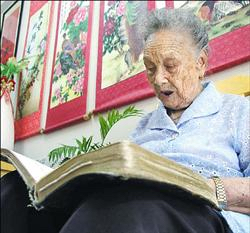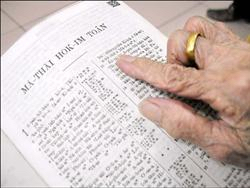Hokkien at UCLA, part 2
« previous post | next post »
Referring to the first post in this series, "Hokkien at UCLA" (4/20/22), Chau Wu writes:
I totally agree with you about the Chinese prerequisite.
When I was younger (no, a lot younger) back in Taiwan, I had known a few grandmotherly Christian ladies who were illiterate in Sinitic script but perfectly at home in reading the Taiwanese Bible in Pe̍h-ōe-jī (POJ), i.e., Church Romanization (see below at * for further discussion). The following pictures appeared in the Taiwanese newspaper 自由時報 (Liberty Times) (Hokkien POJ Chū-iû-sî-pò; Hanyu Pinyin Zìyóu Shíbào) a few years ago about a Mrs. Lin (unrelated to any of the ladies I knew of) reading the Bible (Note the Bible shows signs of having been heavily used):

and the page she opens to is Matthews Chapter 1 (馬太福音傳 MÁ-THÀI HOK-IM TOĀN):

The lady enjoyed reading the Bible everyday.
What infuriated me about that news article was that the reporter said the lady was 目不識丁!!!!
And what does "mùbùshídīng 目不識丁" (lit., "eyes cannot recognize [the character] ding") mean? It conveys the idea of "completely illiterate", since dīng 丁 is one of simplest and easiest Sinographs to recognize and write.
My brother's mother-in-law was perfectly literate in POJ.
———
*Note on POJ:
The name pe̍h-ōe-jī (Chinese: 白話字; pinyin: Báihuà zì) means "vernacular writing", written characters representing everyday spoken language. The name vernacular writing could be applied to many kinds of writing, romanized and character-based, but the term pe̍h-ōe-jī is commonly restricted to the Southern Min romanization system developed by Presbyterian missionaries in the 19th century.
The missionaries who invented and refined the system used, instead of the name pe̍h-ōe-jī, various other terms, such as "Romanized Amoy Vernacular" and "Romanized Amoy Colloquial." The origins of the system and its extensive use in the Christian community have led to it being known by some modern writers as "Church Romanization" (教會羅馬字; Jiàohuì Luōmǎzì; Kàu-hōe Lô-má-jī) and is often abbreviated in POJ itself to Kàu-lô. (教羅; Jiàoluō) There is some debate on whether "pe̍h-ōe-jī" or "Church Romanization" is the more appropriate name.
Objections to "pe̍h-ōe-jī" are that it can refer to more than one system and that both literary and colloquial register Southern Min appear in the system and so describing it as "vernacular" writing might be inaccurate. Objections to "Church Romanization" are that some non-Christians and some secular writing use it. POJ today is largely disassociated from its former religious purpose. The term "romanization" is also disliked by some, who see it as belittling the status of pe̍h-ōe-jī by identifying it as a supplementary phonetic system instead of a standalone orthography.
(source)
Selected readings
- "Writing Sinitic languages with phonetic scripts" (5/20/16)
- "Confessions of an Ex-Hokkien Creationist" (9/20/16)
Philip Taylor said,
April 22, 2022 @ 2:36 am
The two photographs of Mrs Lin reading her bible remind me very much of my favourite work of art — Gerrit Dou's Old lady reading a lectionary. As a result of the Rijksmuseum's incredible generosity in making full-resolution TIFF images of their collection freely available, a full-sized print of this image now adorns the wall of my lounge.
Victor Mair said,
April 22, 2022 @ 6:19 am
@Philip Taylor
Thank you for introducing us to Gerrit Dou's "Old lady reading a lectionary". It is now also my favorite painting.
Lydia Williams said,
April 22, 2022 @ 6:24 am
I must say that I find it quite difficult to see how 目不識丁 expresses the idea of "completely illiterate" i.e. unable to read or write any script. By its literal meaning "eyes cannot recognize [the character] ding" it seems to explicitly and unambiguously mean "illiterate in Chinese characters", which hardly seems like something to be annoyed over, considering that the lady in the quoted anecdote is indeed "illiterate in Sinitic script".
Victor Mair said,
April 22, 2022 @ 7:11 am
@Lydia Williams
Then why would Chau Wu (a native speaker of Hokkien and Mandarin, who is literate in Sinographs) be so upset by the use of that expression to describe Mrs. Lin?
David Marjanović said,
April 22, 2022 @ 6:30 pm
By its own literal meaning, illiterate seems to explicitly and unambiguously mean "devoid of letters"…
(Lītera became littera by a regular process right around the beginning of Classical Latin; the single-t spelling, but not the vowel length or anything corresponding to it, was restored in English literature as an "improvement" on French littérature, and likewise literate vs. lettré.)
Neil said,
April 23, 2022 @ 6:46 am
@Philip Taylor and @Victor Mair, for my own art education, why is this painting your favourite? I took a quick look online, and I gather it’s pointing out hypocrisy— the exhortation to charity vs the lady’s fine clothes. Thank you
Neil said,
April 23, 2022 @ 6:48 am
PS it’s not a criticism of your taste! I am genuinely wondering, as my art education leaves much to be desired
Philip Taylor said,
April 23, 2022 @ 9:19 am
In my case, because seeing it in the flesh (as I was privileged to do in the Mauritshuis, Den Haag, some years ago, it simply took my breath away. Gerrit Dou's incredible ability to capture not only the texture of the woman's face, skin and fur collar, but also to be able to replicate so accurately the typography of the lectionary, left me absolutely staggered. Alongside it, "Girl with pearl earing" looked nothing but a poor pastiche. Any underlying sub-text (e.g., a depiction of hypocrisy) made no impression on me whatsoever — I was looking at it as a painting (qua painting, or perhaps 'work of art'), nothing more. Even after visiting the Rijksmuseum and looking at their incredible collection of old Dutch/Flemish masters, none had the impact on me that Old lady reading a lectionary did.
Victor Mair said,
April 23, 2022 @ 2:00 pm
I haven't even been to Mauritshuis, Den Haag, to see it in the flesh, but I have the same reaction as Philip Taylor.
If there is a subtext for me, it is that of beholding the miracle of reading, especially for an old woman reading a lectionary, which gives me the same sort of chill / thrill as that of beholding Mrs. Lin reading her Romanized POJ Bible.
Terpomo said,
April 23, 2022 @ 3:35 pm
The ideologies of literacy in the Sinitic world privilege Chinese characters, that's not news. (If anything it's one of the defining features of the Sinitic world; the Dungans, for instance, speak an unmistakably Sinitic language, but they're somewhat removed from Chinese/Han culture mainly because of their non-use of hanzi.)
Neil said,
April 23, 2022 @ 6:20 pm
@victor Mair and Philip Taylor, thanks for taking the time to respond
Victor Mair said,
April 26, 2022 @ 7:25 pm
From Chau Wu:
Regarding Matthew's Gospel, the earliest printed version in any Taiwanese languages is that of Dutch-Siraya (西拉雅) bilingual text in alphabetic script published in 1661:
See:
https://en.wikipedia.org/wiki/Siraya_language
西拉雅族 – 維基百科,自由的百科全書